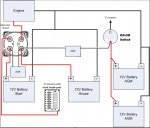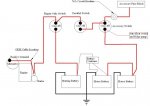Re: Wire gauge question from alternator
Here's Blue Sea's wiring diagram for an ACR, though it's not a perfect fit in your situation since you have 3 batteries.
http://bluesea.com/files/resources/sales_sheets/6838.pdf
If you are OK with flipping the "galley" battery switch from 1-2-BOTH to charge the AGM batteries, and then again while on the hook to use only 1 battery at a time, 1 ACR will work, but it seems like a PITA to me. The problem I see with 1 ACR charging the 2 AGM batteries (and the battery switches you mentioned) is that you will need to wire the AGM batteries in parallel to charge them both "automatically",,, but this will defeat the battery switch in the galley. Either that or you will have to remember to flip the galley's switch to both while motoring, but again that seems like a PITA. The only way I can see charging each AGM battery automatically, while switched off, is to use 2 ACR's, 1 for each AGM battery.
For wiring, I would run heavy gauge battery cable to the AGM batteries and switches so you can start the boat off the AGM batteries if needed. There are a couple ways of wiring the switches, depending on your needs, but here's 1 way
- Heavy gauge battery cable from batteries to switches and engine.
- In the galley, connect 2 ACR's to the battery switch's common post and then over to post #1 and #2 using 10-8ga wire. (if there is such a thing as an ACR with 2 switched outputs, use 1 of those)
In this scenerio when you flip the engine's battery switch to both it will connect the engine to the start battery and galley battery switch, then when you start the engine the AGM batteries will charge. While on the hook, flip the engine's battery switch off and you can run your galley loads off the AGM batteries, selectable by the galley's battery switch. If your engine battery dies, switch the engine battery switch to #2 and the galley switch to the best battery and start the engine.
I guess another way to wire it would be to place the ACR on the engine battery switch's #2 post and then run 8-6 gauge wire to the galley battery switch and AGM batteries. But then the only thing the AGM batteries would do is run galley loads, they wouldn't be able to start the engine in an emergency situation when the engine battery is dead and you have to start the engine NOW! Be aware that there is a possibility of fire if connecting thin gauge wire (not battery cable) between the switch and batteries, and then trying to pull a high current load down the wire... IE: trying to start the engine with the AGM batteries,,, by manually locking the ACR(s) closed. If your ACR does not have the manual lock feature or you don't wire it up, I don't think you will have a problem running 8-6ga wire for the AGM batteries. (Personally, I wouldn't connect a battery to a battery switch with 6-8ga unless it was protected with a breaker)
{
EDIT: I didn't notice you had a
house battery in the stern (1 more battery) so I edited my post to make some kind of sense...

I guess you don't have to worry about redundancy for the start battery}






















